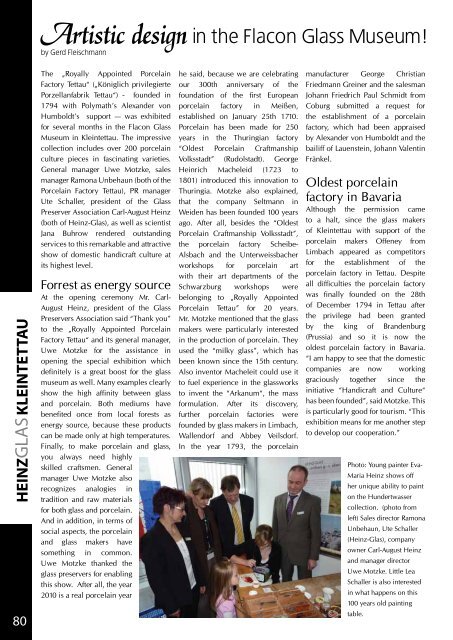78976013376073041739.pdf
78976013376073041739.pdf
78976013376073041739.pdf
Sie wollen auch ein ePaper? Erhöhen Sie die Reichweite Ihrer Titel.
YUMPU macht aus Druck-PDFs automatisch weboptimierte ePaper, die Google liebt.
HEINZGLAS KLEINTETTAU<br />
Artistic design<br />
by Gerd Fleischmann<br />
The „Royally Appointed Porcelain<br />
Factory Tettau“ („Königlich privilegierte<br />
Porzellanfabrik Tettau“) - founded in<br />
1794 with Polymath’s Alexander von<br />
Humboldt’s support — was exhibited<br />
for several months in the Flacon Glass<br />
Museum in Kleintettau. The impressive<br />
collection includes over 200 porcelain<br />
culture pieces in fascinating varieties.<br />
General manager Uwe Motzke, sales<br />
manager Ramona Unbehaun (both of the<br />
Porcelain Factory Tettau), PR manager<br />
Ute Schaller, president of the Glass<br />
Preserver Association Carl-August Heinz<br />
(both of Heinz-Glas), as well as scientist<br />
Jana Buhrow rendered outstanding<br />
services to this remarkable and attractive<br />
show of domestic handicraft culture at<br />
its highest level.<br />
Forrest as energy source<br />
At the opening ceremony Mr. Carl-<br />
August Heinz, president of the Glass<br />
Preservers Association said “Thank you”<br />
to the „Royally Appointed Porcelain<br />
Factory Tettau“ and its general manager,<br />
Uwe Motzke for the assistance in<br />
opening the special exhibition which<br />
definitely is a great boost for the glass<br />
museum as well. Many examples clearly<br />
show the high affinity between glass<br />
and porcelain. Both mediums have<br />
benefited once from local forests as<br />
energy source, because these products<br />
can be made only at high temperatures.<br />
Finally, to make porcelain and glass,<br />
you always need highly<br />
skilled craftsmen. General<br />
manager Uwe Motzke also<br />
recognizes analogies in<br />
tradition and raw materials<br />
for both glass and porcelain.<br />
And in addition, in terms of<br />
social aspects, the porcelain<br />
and glass makers have<br />
something in common.<br />
Uwe Motzke thanked the<br />
glass preservers for enabling<br />
this show. After all, the year<br />
2010 is a real porcelain year<br />
80 HÜTTENPOST 2011<br />
in the Flacon Glass Museum!<br />
he said, because we are celebrating<br />
our 300th anniversary of the<br />
foundation of the first European<br />
porcelain factory in Meißen,<br />
established on January 25th 1710.<br />
Porcelain has been made for 250<br />
years in the Thuringian factory<br />
“Oldest Porcelain Craftmanship<br />
Volksstadt” (Rudolstadt). George<br />
Heinrich Macheleid (1723 to<br />
1801) introduced this innovation to<br />
Thuringia. Motzke also explained,<br />
that the company Seltmann in<br />
Weiden has been founded 100 years<br />
ago. After all, besides the “Oldest<br />
Porcelain Craftmanship Volksstadt”,<br />
the porcelain factory Scheibe-<br />
Alsbach and the Unterweissbacher<br />
workshops for porcelain art<br />
with their art departments of the<br />
Schwarzburg workshops were<br />
belonging to „Royally Appointed<br />
Porcelain Tettau” for 20 years.<br />
Mr. Motzke mentioned that the glass<br />
makers were particularly interested<br />
in the production of porcelain. They<br />
used the “milky glass”, which has<br />
been known since the 15th century.<br />
Also inventor Macheleit could use it<br />
to fuel experience in the glassworks<br />
to invent the “Arkanum“, the mass<br />
formulation. After its discovery,<br />
further porcelain factories were<br />
founded by glass makers in Limbach,<br />
Wallendorf and Abbey Veilsdorf.<br />
In the year 1793, the porcelain<br />
manufacturer George Christian<br />
Friedmann Greiner and the salesman<br />
Johann Friedrich Paul Schmidt from<br />
Coburg submitted a request for<br />
the establishment of a porcelain<br />
factory, which had been appraised<br />
by Alexander von Humboldt and the<br />
bailiff of Lauenstein, Johann Valentin<br />
Fränkel.<br />
Oldest porcelain<br />
factory in Bavaria<br />
Although the permission came<br />
to a halt, since the glass makers<br />
of Kleintettau with support of the<br />
porcelain makers Offeney from<br />
Limbach appeared as competitors<br />
for the establishment of the<br />
porcelain factory in Tettau. Despite<br />
all difficulties the porcelain factory<br />
was finally founded on the 28th<br />
of December 1794 in Tettau after<br />
the privilege had been granted<br />
by the king of Brandenburg<br />
(Prussia) and so it is now the<br />
oldest porcelain factory in Bavaria.<br />
“I am happy to see that the domestic<br />
companies are now working<br />
graciously together since the<br />
initiative “Handicraft and Culture“<br />
has been founded”, said Motzke. This<br />
is particularly good for tourism. “This<br />
exhibition means for me another step<br />
to develop our cooperation.”<br />
Photo: Young painter Eva-<br />
Maria Heinz shows off<br />
her unique ability to paint<br />
on the Hundertwasser<br />
collection. (photo from<br />
left) Sales director Ramona<br />
Unbehaun, Ute Schaller<br />
(Heinz-Glas), company<br />
owner Carl-August Heinz<br />
and manager director<br />
Uwe Motzke. Little Lea<br />
Schaller is also interested<br />
in what happens on this<br />
100 years old painting<br />
table.


